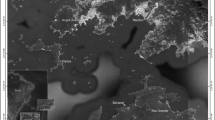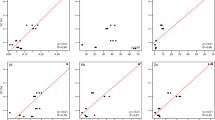Abstract
The diffusive gradients in thin films (DGT) were field deployed alongside the shrimp Litopenaeus vannamei at seven sites with different levels of contamination to assess the potentially bioavailable and toxic fraction of metal contaminants. After 7 days of exposure, several antioxidant biomarkers were quantified in hepatopancreas of exposed shrimps, and tissue levels as well as the total, dissolved, and DGT-labile concentrations of metal contaminants were determined in the pooled site samples. The results showed that the caged shrimps had high tissue contaminant concentrations and significantly inhibited antioxidant responses at the more contaminated sites. DGT-labile metal concentrations provided better spatial resolution of differences in metal contamination when compared with traditional bottle sampling and transplanted shrimp. The total, dissolved, and DGT-labile metal fractions were used to evaluate the potential bioavailability of metal contaminants, comparing with metal accumulation and further linking to antioxidant biomarker responses in tissues of exposed shrimps. Regression analysis showed the significant correlations between DGT-Cu concentrations and tissue-Cu and activities of some biomarker responses in the shrimp hepatopancreas. This indicated that DGT-labile Cu concentrations provided the better prediction of produced biological effects and of the bioavailability than the total or dissolved concentrations. The study supports the use of methods combining transplanted organisms and passive sampling for assessing the chemical and ecotoxicological status of aqueous environments and demonstrates the capability of the DGT technique as a powerful tool for measuring the bioavailability-based water quality in variable coastal environments.





Similar content being viewed by others
References
Aebi H (1974) Methods of enzymatic analysis. In: Bergmayer HU (ed) Catalase. Academic, London, pp 671–684
Allan IJ, Knutsson J, Guigues N, Mills GA, Fouillac AM, Greenwood R (2007) Evaluation of the Chemcatcher and DGT passive samplers for monitoring metals with highly fluctuating water concentrations. J Environ Monitor 9:672–681
Barata C, Lekumberri I, Vila-Escale M, Prat N, Porte C (2005) Trace metal concentration, antioxidant enzyme activities and susceptibility to oxidative stress in the tricoptera larvae Hydropsyche exocellata from the Llobregat river basin (NE Spain). Aquat Toxicol 74:3–19
Bervoets L, Voets J, Covaci A, Chu SG, Qadah D, Smolders R, Schepens P, Blust R (2005) Use of transplanted zebra mussels (Dreissena polymorpha) to assess the bioavailability of microcontaminants in Flemish surface waters. Environ Sci Technol 39:1492–1505
Bowles KC, Apte SC, Batley GE, Hales LT, Rogers NJ (2006) A rapid Chelex column method for the determination of metal speciation in natural waters. Anal Chim Acta 558:237–245
Bradford MM (1976) Rapid and sensitive method for quantification of microgram quantities of protein utilizing principle of protein–dye binding. Anal Biochem 72:248–254
Buzier R, Tusseau-Vuillemin MH, Mouchel JM (2006) Evaluation of DGT as a metal speciation tool in wastewater. Sci Total Environ 358:277–285
Dabrin A, Durand CL, Garric J, Geffard O, Ferrari BJD, Coquery M (2012) Coupling geochemical and biological approaches to assess the availability of cadmium in freshwater sediment. Sci Total Environ 424:308–315
Dragun Z, Podrug M, Raspor B (2009) Combined use of bioindicators and passive samplers for the assessment of river water contamination with metals. Arch Environ Contam Toxicol 57:211–220
Faria M, Carrasco L, Diez S, Riva MC, Bayona JM, Barata C (2009) Multi-biomarker responses in the freshwater mussel Dreissena polymorpha exposed to polychlorobiphenyls and metals. Comp Biochem Phys C 149:281–288
Gimpel J, Zhang H, Davison W, Edwards AC (2003) In situ trace metal speciation in lake surface waters using DGT, dialysis, and filtration. Environ Sci Technol 37:138–146
Guéguen C, Clarisse O, Perroud A, Mcdonald A (2011) Chemical speciation and partitioning of trace metals (Cd, Co, Cu, Ni, Pb) in the lower Athabasca river and its tributaries (Alberta, Canada). J Environ Monitor 13:2865–2872
Habig WH, Pabst MJ, Jakoby WB (1974) Glutathione S-transferases: the first enzymatic step in mercapturic acid formation. J Biol Chem 249:7130–7139
Hédouin L, Pringault O, Bustamante P, Fichez R, Warnau M (2011) Validation of two tropical marine bivalves as bioindicators of mining contamination in the New Caledonia lagoon: field transplantation experiments. Water Res 45:483–496
Jordan MA, Teasdale PR, Dunn RJK, Lee SY (2008) Modelling copper uptake by Saccostrea glomerata with diffusive gradients in a thin film measurements. Environ Chem 5:274–280
Kubrak OI, Husak VV, Rovenko BM, Poigner H, Mazepa MA, Kriews M, Abele D, Lushchak VI (2012) Tissue specificity in nickel uptake and induction of oxidative stress in kidney and spleen of goldfish Carassius auratus, exposed to waterborne nickel. Aquat Toxicol 118–119:88–96
Leonard SS, Harris GK, Shi XL (2004) Metal-induced oxidative stress and signal transduction. Free Radic Biol Med 37:1921–1942
Leung KMY, Furness RW, Svavarsson J, Lau TC, Wu RSS (2008) Field validation, in Scotland and Iceland, of the artificial mussel for monitoring trace metals in temperate seas. Mar Pollut Bull 57:790–800
Liu Y, Wang WN, Wang AL, Wang JM, Sun RY (2007) Effects of dietary vitamin E supplementation on antioxidant enzyme activities in Litopenaeus vannamei (Boone, 1931) exposed to acute salinity changes. Aquaculture 265:351–358
Livingstone DR, Lips F, Martinez PG, Pipe RK (1992) Antioxidant enzymes in the digestive gland of the common mussel Mytilus edulis. Mar Biol 112:265–276
Luider CD, Crusius J, Playle RC, Curtis PJ (2004) Influence of natural organic matter source on copper speciation as demonstrated by Cu binding to fish gills, by ion selective electrode, and by DGT gel sampler. Environ Sci Technol 38:2865–2872
McCord JM, Fridovich I (1969) Superoxide dismutase: an enzymatic function for erythrocuprein (hemocuprein). J Biol Chem 244:6049–6055
McGeer JC, Brix KV, Skeaff JM, DeForest DK, Brigham SI, Adams WJ, Green A (2003) Inverse relationship between bioconcentration factor and exposure concentration for metals: implications for hazard assessment of metals in the aquatic environment. Environ Toxicol Chem 22:1017–1037
Miege C, Mazzella N, Schiavone S, Dabrin A, Berho C, Ghestem JP, Gonzalez C, Gonzalez JL, Lalere B, Lardy-Fontan S, Lepot B, Munaron D, Tixier C, Togola A, Coquery M (2012) An in situ intercomparison exercise on passive samplers for monitoring metals, polycyclic aromatic hydrocarbons and pesticides in surface waters. Trends Anal Chem 36:128–143
Montero N, Belzunce-Segarra MJ, Gonzalez JL, Larreta J, Franco J (2012) Evaluation of diffusive gradients in thin-films (DGTs) as a monitoring tool for the assessment of the chemical status of transitional waters within the water framework directive. Mar Pollut Bull 64:31–39
Neff JM (2002) Bioaccumulation in marine organisms. Elsevier, Oxford
Pereira P, Pablo HD, Vale C, Pacheco M (2010) Combined use of environmental data and biomarkers in fish (Liza aurata) inhabiting a eutrophic and metal-contaminated coastal system—gills reflect environmental contamination. Mar Environ Res 69:53–62
Pourang N, Dennis JH (2005) Distribution of trace elements in tissues of two shrimp species from the Persian Gulf and roles of metallothionein in their redistribution. Environ Int 31:325–341
Renner R (1997) Rethinking water quality standards for metals toxicity. Environ Sci Technol 31:466A–468A
Roig N, Nadal M, Sierra J, Ginebreda A, Schuhmacher M, Domingo JL (2011) Novel approach for assessing heavy metal pollution and ecotoxicological status of rivers by means of passive sampling methods. Environ Int 37:671–677
Schintu M, Durante L, Maccinoni A, Meloni P, Degetto S, Contu A (2008) Measurement of environmental trace-metal levels in Mediterranean coastal areas with transplanted mussels and DGT techniques. Mar Pollut Bull 57:832–837
Sedlak DL, Phinney JT, Bedsworth WW (1997) Strongly complexed Cu and Ni in wastewater effluents and surface runoff. Environ Sci Technol 31:3010–3016
Sherwood JE, Barnett D, Barnett NB, Dover K, Howitt J, Hiroyuki I, Kew P, Mondon J (2009) Deployment of DGT units in marine waters to assess the environmental risk from a deep sea tailings outfall. Anal Chim Acta 652:215–223
Simpson SL, Yverneau H, Cremazy A, Jarolimek CV, Price HL, Jolley DF (2012) DGT-induced copper flux predicts bioaccumulation and toxicity to bivalves in sediments with varying properties. Environ Sci Technol 46:9038–9046
Slaveykova VI, Karadjova IB, Karadjov M, Tsalev DL (2009) Trace metal speciation and bioavailability in surface waters of the black sea coastal area evaluated by HF-PLM and DGT. Environ Sci Technol 43:1798–1803
Topperwien S, Xue HB, Behra R, Sigg L (2007) Cadmium accumulation in Scenedesmus vacuolatus under freshwater conditions. Environ Sci Technol 41:5383–5388
Tusseau-Vuillemin MH, Gilbin R, Bakkaus E, Garric J (2004) Performance of diffusin gradient in thin films to evaluate the toxic fraction of copper to Daphnia magna. Environ Toxicol Chem 23:2154–2161
Valavanidis A, Vlahogianni T, Dassenakis M, Scoullos M (2006) Molecular biomarkers of oxidative stress in aquatic organisms in relation to toxic environmental pollutants. Ecotoxicol Environ Safe 64:178–189
Wang ZS, Yan CZ, Hyne RV (2010) Effects of dietary cadmium exposure on reproduction of saltwater cladoceran Moina monogolica Daday: implications in water quality criteria. Environ Toxicol Chem 29:365–372
Wang ZS, Yan CZ, Pan QK, Yan YJ (2011) Concentrations of some heavy metals in water, suspended solids, and biota species from Maluan Bay, China and their environmental significance. Environ Monit Assess 175:239–249
Webb JA, Keough MJ (2002) Measurement of environmental trace-metal levels with transplanted mussels and diffusive gradients in thin films (DGT): a comparison of technique. Mar Pollut Bull 44:222–229
Winston GW, Di Giulio RT (1991) Prooxidant and antioxidant mechanisms in aquatic organisms. Aquat Toxicol 19:137–161
Wu XY, Yang YF (2011) Heavy metal (Pb, Co, Cd, Cr, Cu, Fe, Mn and Zn) concentrations in harvest-size white shrimp Litopenaeus vannamei tissues from aquaculture and wild source. J Food Compos Anal 24:62–65
Wu JP, Chen HC, Huang DJ (2008) Histopathological and biochemical evidence of hepatopancreatic toxicity caused by cadmium and zinc in the white shrimp, Litopenaeus vannamei. Chemosphere 73:1019–1026
Zhang H, Davison W (1995) Performance characteristics of diffusion gradients in thin films for the in situ measurement of trace metals in aqueous solution. Anal Chem 67:3391–3400
Acknowledgments
This research was supported by the National Nature Science Foundation of China (NSFC), awarded for the project “Dynamic variation of metal bioavailability and its responsive mechanisms of molecular biomarkers based on in-situ exposure” (grant no. 21377125/B070403 to Dr. Wang). Financial support was also provided to produce the deployment devices by grant no. 3502z20110005 from Xiamen engineering center and grant no. 2011DFB91710 from the International Science and Technology Cooperation Program, China. Furthermore, Chris Vulpe is supported by US NSF Grant CBET-1066358. The authors would like to thank Dr. Zhang Hao of Lancaster University, United Kingdom, for providing the DGT probes on which this work was based. Dr. Wang wishes to acknowledge financial support of this research by the China Scholarship Council (CSC) for supporting his stay at University of California, Berkeley as visiting scholar (File No. 201204910004). Special thanks are extended to the Dr. Dave Mount of US EPA in Duluth for insightful discussions when Dr. Wang attended the 32nd SETAC North America annual meeting in Boston.
Author information
Authors and Affiliations
Corresponding authors
Additional information
Responsible editor: Philippe Garrigues
Electronic supplementary material
Below is the link to the electronic supplementary material.
Fig. S1
Spatial patterns of metal accumulation (ng g−1 DW) in pooled hepatopancreas of transplanted L. vannamei after a 7-day field exposure at seven deployment sites. Bars presenting the same letter (a, b, c, or d) are not significantly different (p < 0.05, Student–Newman–Keuls multiple-range tests). RS reference shrimp. (JPEG 92 kb)
Fig. S2
Biomarker responses of antioxidant enzyme activities measured in the hepatopancreas of L. vannamei after a 7-day field exposure at deployment sites. Bars sharing the same letters (a, b, c, d, e, f, or g) denote not statistically significant differences (p < 0.05) between deployment sites. RS reference shrimp. (JPEG 58 kb)
Table S1
(DOC 49 kb)
Table S2
(DOC 34 kb)
Rights and permissions
About this article
Cite this article
Wang, Z., Zhao, P., Yan, C. et al. Combined use of DGT and transplanted shrimp (Litopenaeus vannamei) to assess the bioavailable metals of complex contamination: implications for implementing bioavailability-based water quality criteria. Environ Sci Pollut Res 21, 4502–4515 (2014). https://doi.org/10.1007/s11356-013-2415-1
Received:
Accepted:
Published:
Issue Date:
DOI: https://doi.org/10.1007/s11356-013-2415-1




